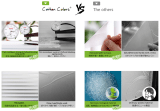
About the CR-180
The Canon CR-180 device is a durable,
high-speed back counter scanning system
used by banks, credit unions, check-clearing
houses, and large retail operations. With duplex
s
c
anning speeds of 180 checks per minute*
and highly accurate MICR read capabilities, the CR-180 is one
of the fastest and most affordable compact devices in its class.
The C
R-180 device supports an average daily volume of up to
20,000 checks, and batches of up to 200 items can be scanned
simultaneously and automatically sorted to two different output
pockets using preconfigured rules based on the MICR data on the
checks. Featuring a built-in jogger unit and prescan imprinter,
the CR-180 system delivers outstanding functionality and value.
About the CR-55
Whether deployed at the teller line in bank
branches or commercial/retail locations, the
C
R
-55 device of
f
ers the perfect combination
of functionality, size, and speed for distributed
check imaging applications, including branch
c
apt
ure and r
emote deposit. For unmatched image reproduction,
t
he user-friendly CR-55 device offers a choice of high-quality scan-
ning in black and white, grayscale, or 24-bit color and resolutions
of
up t
o 300 dpi. The
CR-55 device captures MICR data along with
images of both sides of checks at a fast 55 check-per-minute*
speed. A built-in prescan imprinter comes standard and the device
also f
e
at
ures infrared double-feed detection for dependable paper
feeding and image capture. Designed for a wide range of check
processing environments, the CR-55 device requires minimal
tr
ainin
g and ef
f
ortless operation.
GLOSSARY
Automatic Clearing House
(ACH)
- Networks in the U.S. used to clear
electronic high-volume, low-value payments.
A
pplication Service Provider
(
ASP)
-
A service provider will actually
host a remote deposit application for a bank. A remote deposit ASP
will deliver the remote deposit application services to the bank’s
customers, receive the check image data from those customers,
and transmit the data to the bank.
BOFD
- Bank of First Deposit.
Courtesy Amount Recognition (CAR) - The ability to automatically
locate, analyze, and recognize handwritten or machine-printed
courtesy amounts on documents. The Courtesy Amount is the
check value written in numeric form.
Centralized Capture
- Banks will have operational facilities,
either single or regional, where all checks deposited at the
bank are transported to be processed and cleared.
Check 21
- The Check Clearing for the 21st Century Act was signed
into United States law on October 28, 2003. The law facilitates check
truncation by creating a new negotiable instrument called a substitute
check or Image Replacement Document (IRD) that permits banks to
truncate original checks, process check information electronically,
and deliver substitute checks to banks that want to continue
receiving paper checks.
Check Truncation
- The practice of holding a check at the last point in
the clearing process and not returning it with the monthly statement;
typically confined to credit unions and money markets. (The term
“truncation” is incorrectly used in the “Check Truncation Act”; the
term should actually be “conversion” or the “Check Conversion Act.”)
Distributed Capture
- Capturing the data from a check at the point
of deposit; includes teller, branch back office, remotely at a business
entity location, and at an ATM.
Electronic Check Presentment (ECP)
- A service that provides for
an electronic payment to be debited from a customer’s bank account
and transferred to a business’ bank account. It is often used for
recurring payments and for businesses wanting to simplify and
reduce the cost associated with collecting payments from customers.
Encode
- To place magnetic ink characters on the face of an item.
Usually refers to the dollar amount.
E
ndorsement
-
Check payment approval and audit information
applied to the rear of a check. The payee will sign the check for cashing
or deposit. The depositing institution will print their name, location, and
date information when deposited. Automatic equipment will apply date
and reference numbers on the check for auditing and research purposes.
Float
- The dollar amount of items outstanding and in the process
of being collected by banks; also called uncollected float.
Image Replacement Document (IRD)
- A substitute machine-readable
image copy (as a paper reproduction of the original check) that may,
under certain legal arrangements, be the practical and legal equivalent
of the original check. Also known as Substitute Check, the term IRD
is used by the Accredited Standards Committee in the technical
specification for substitute checks.
Legal Amount Recognition
(LAR)
- Technology to read the amount
written/printed in words from a check image.
Lockbox
- A bill payment is typically addressed to a Post Office box
number. The address will actually be a service provider for the biller,
who will then receive and process the payments.
Lockbox Check Conversion
- The process of converting checks
received in the mail by a biller into electronic items.
Magnetic Ink Character Recognition (MICR)
- The font that is imprinted
at the bottom of a check or other financial documents by equipment using
ink with iron-oxide pigments capable of being magnetized. Transports
can either read these characters magnetically (actually “charging” the
characters) or optically. A magnetic read of the characters is normally
more accurate. The font style for MICR characters is called E-13B.
Remote Capture
- Capturing the data at a business entity location.
A business will use remote deposit to capture and transmit their
received checks over the Internet to their bank for deposit.
* Examples based on typical settings, rated in checks/images per minute with U.S. personal checks @ 200 dpi in black and white or grayscale.














